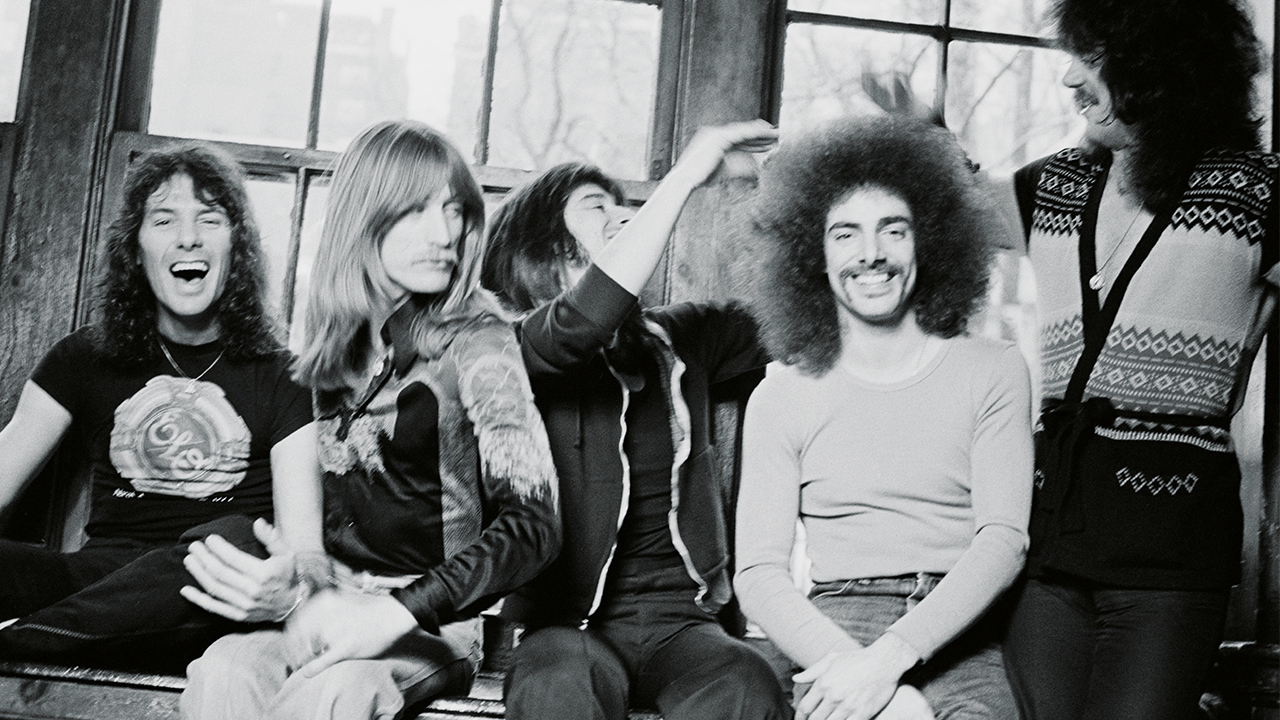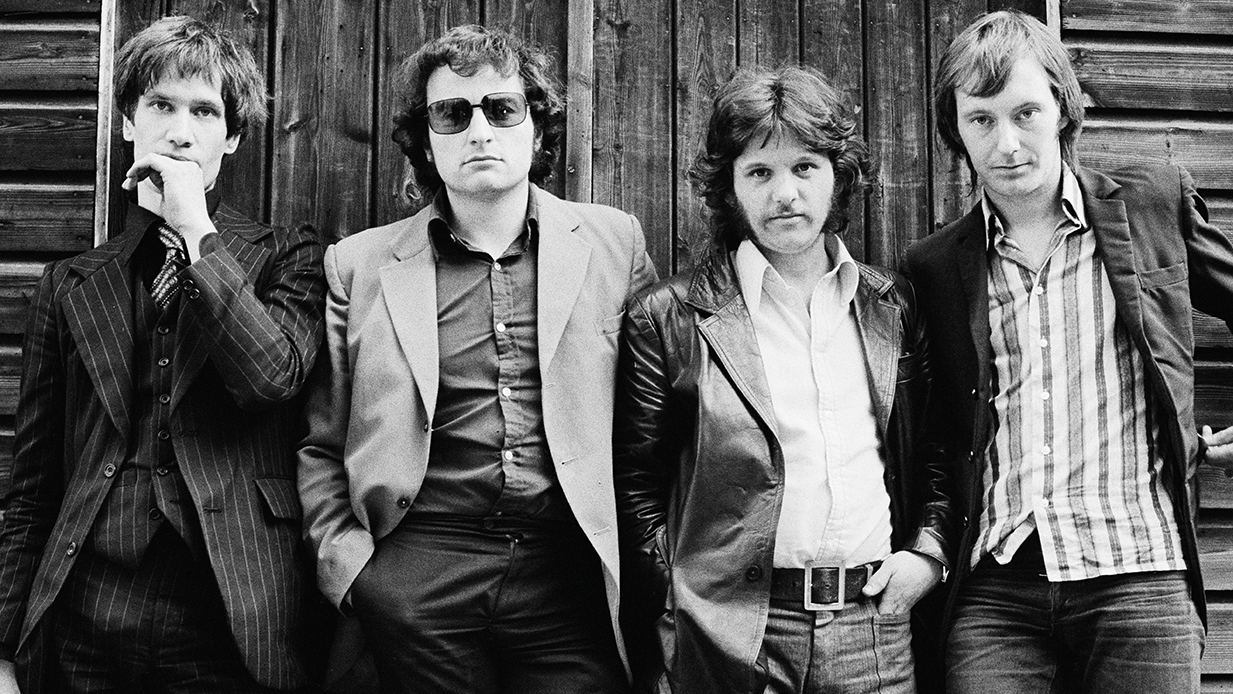Our Greatest Albums Of The 70s, numbers 42 to 32.
42) SPACE SHANTY – Khan (Deram, 1972)
The only album recorded by the short-lived Canterbury-scene band whose principal players were guitarist Steve Hillage and former Egg/future Hatfield And The North keyboard whizz Dave Stewart, Space Shanty is buried treasure. Musicianly, at times heavyweight, at others spacey or jazzy, it’s a true 70s prog classic that deserves to be known by more than just the genre’s know-it-alls. The playing of Hillage and Stewart in particular is highly accomplished, although heard today the occasionally cringeworthy lyrics and some space-cadet song titles – try Stranded (Including Effervescent Psycho Novelty No. 5 or Space Shanty (Including ‘The Cobalt Sequence’ And ‘March Of The Sine Squadrons’) for size – might deter the more earth-bound punter.
41) GRAND HOTEL – Procol Harum (Chrysalis, 1973)
All you really need to know about Grand Hotel is that the epic immensity of its title track’s choir, orchestra, soaring guitar solo and kitchen sink-encumbered mid-section inspired Douglas Adams to conceive The Restaurant At The End Of The Universe. Obviously, ear‑witnesses of less vision condemned the Procols’ ever-expanding conceptual immensity, but there’s an album’s worth of ear-bleeding pomp crammed into every single stanza.
What they said at the time: “Grand Hotel is a collection of overblown production jobs that at their worst approach self-parody, and simpler, less grandiose tracks that suggest Procol Harum may yet find a way out.” Rolling Stone
40) SONGS FROM THE WOOD – Jethro Tull (Chrysalis, 1977)
Forever eclipsed by Jethro Tull’s big hitters – Aqualung and Thick As A Brick – Songs From The Wood was band leader Ian Anderson’s wonderfully un-chic salute to English country life. Released in the same month that Sid Vicious joined the Sex Pistols, the whole thing sounds like Anderson bulldozing Vivienne Westwood’s SEX shop in his tractor. Rendered on flutes, mandolins and a pipe organ, these cheery odes to farm life, pagan rituals and al fresco coupling with ‘high-born hunting girls’ had a tuneful immediacy absent from many of Jethro Tull’s earlier and more revered albums.
What they said at the time: “Jethro Tull have revamped their old medieval image. Unfortunately the whole affair sounds like the background music to TV’s Robin Hood.” Sounds
39) TOM PETTY AND THE HEARTBREAKERS – Tom Petty And The Heartbreakers (Shelter, 1976)
Tom Petty may have been a blond longhair, but his debut album had new wave values: a testament to short, sharp musicianship and melodic concision after years of jamming and boogie. Anything That’s Rock’N’Roll was a restatement of first principles. Rockin’ Around (With You) flew out of the traps with energy to spare, all pop harmonies and country flair. Fooled Again (I Don’t Like It) matched Springsteen for slow-burning intensity. And highlight American Girl had the freewheeling spirit of peak-era Byrds, mixed with the urgency of punk. A star was born.
What they said at the time: “Purely and simply the best mainstream rock debut by any American band this year.” Sounds

38) INFINITY – Journey (CBS, 1978)
After three albums in the jazz-rock idiom, Journey made a massive switch in direction. With frontman Steve Perry on board, they went for a melodic rock approach that put them firmly in the Foreigner/Boston camp.
It worked. Infinity was stuffed with radio-friendly songs such as Wheel In The Sky and Lights, and it became a huge seller in the US. Roy Thomas Baker’s deft production helped to swell the sounds, giving Journey their own disrinctive style.
The band had started recording Infinity with vocalist Robert Fleishman, but this didn’t work out, although he did co-write Wheel In The Sky. However, Perry never saw himself as Journey’s second-choice vocalist. “I wasn’t brought in to replace anyone!” he claimed at the time.
“We decided it was time to get more song-oriented,” revealed keyboard player Gregg Rolie. “So when someone suggested we should get in a vocalist, we all said: ‘Sure’.”
Guitarist Neil Schon admitted that Journey really had reached a crossroads. “We were all starving to death. It was time to make a living out of this, or I was gonna have to get a job selling ladies shoes.”
What the band managed to do was retain their obvious musical credibility and build on this with an overtly tuneful structure. It was vital having Baker on board as producer; he was used to working with Queen, who also had a significant balance between virtuosity and the mainstream.
The relationship between Perry and Schon was crucial on this album, as was shown by the powerful music and lyrical rhetoric on songs like Patiently – “It’s the first song I ever wrote for any band,” said Perry – and Somethin’ To Hide. But it was the way in which the smooth and individual vocal approach from Perry informed the rigorous instrumentation from Schon and Rolie that really resonated with a new, expanded fan base. Wheel In The Sky, the first single from Infinity, got major radio play, as Journey were viewed as a new band, such had been the lack of impact made by their previous albums.
Now acknowledged as a hugely influential AOR classic, Infinity was overlooked by the media back then due to Journey having lacked an obvious image. But the album gave the band a commercial platform.
What they said at the time: “Good rock’n’roll has always had its share of risks. Journey has faced them with an entirely new sound.” Circus
37) MOTORHEAD – Motörhead (Chiswick, 1977)
A certain fairy-tale quality surrounds the debut album that applied a defibrillator to Motörhead’s fast-fading corpse after United Artists had opted to shelve its original incarnation, later known as On Parole. With Chiswick boss Ted Carroll agreeing to back a bargain-basement revision of most of its songs, the album has a rudimentary production from Speedy Keen of Thunderclap Newman fame that fails to disguise the sheer quality of the group’s material, and also their thunderously unique delivery.
What they said at the time: “Unbearably loud and heavy, Motörhead have added another dimension to the darker side of heavy metal – sort of Steppenwolf meets Sabbaff and beyond.” Trouser Press
36) MOTT – Mott The Hoople (CBS, 1973)
It broke up the band, with Mick Ralphs leaving for Bad Company soon after its release. Yet Mott arguably remains the definitive Hoople album, created while surfing an overdue surge in popularity and offering both jubilant hits and introspective, autobiographical ballads. It proved that Ian Hunter could write rollicking instant classics such as All The Way From Memphis and Honaloochie Boogie, then break your heart with the tenderness of I Wish I Was Your Mother. Glam and gritty, the dudes were blazing.
What they said at the time: “Mott is the album All The Young Dudes should have been… arrogant, defensive… burned but still sane and making the best music they ever have.” Let It Rock
35) RED – King Crimson (Island, 1974)
After blueprinting prog’s widescreen flights for five years, Robert Fripp was steering Crimson in darker directions by the time Bill Bruford left Yes to join bassist John Wetton in rock’s heaviest rhythm section (which Fripp likened to a “flying brick wall”). Red’s power trio line‑up forged bludgeoning, monolithic riffs, as heard on the brutally malevolent title track and the calm-before-the-storm of Starless. Too dark for fans, Red was Crimson’s first album not to reach the Top 30. Fripp then split King Crimson for five years, while Red built its own cult, including Kurt Cobain.
What they said at the time: “Grand, powerful, grating and surprising lyrical…this does for classical-rock fusion what John McLaughlin’s Devotion did for jazz-rock fusion.” Village Voice
34) L.A.M.F. – Heartbreakers (Track, 1977)
When ex-New York Doll Johnny Thunders’ Heartbreakers landed in the London of 1976 they transformed the punk scene. This was what attitude looked and sounded like. Not all who saw them could play like them –some just settled for a smack habit. Beset by production woes, their Like A Mother Fucker debut finally emerged late, flawed and muddy. It didn’t matter. Their core constituency, listening on cheap Dansettes, didn’t notice. L.A.M.F. is the sound of the city, a swaggering soundtrack to good drugs and bad decisions. Infinitely inspirational, it’s an enduring triumph of abject juvenile delinquency.
What they said at the time: “The cover tells it: big city outlaws, uncompromising, battered but tough - the attitude. Music to get wrecked to, not intellectual, studied, or subtle.” Sounds
33) STUPIDITY – Dr Feelgood (United Artists, 1976)
The arsey concision of the Feelgoods’ third LP was the perfect antidote to the flabby complacency of Californian soft rock. A sharp symbiosis of Lee Brilleaux’s tough vocals and the terse choppiness of Wilko Johnson’s guitar lines, it was also the first live album to top the UK charts in its first week. “This was the culmination of the revolution against the stack heel and platform shoes brigade,” remarked Brilleaux. “We said bollocks to all that, this is how a live band really goes to work.”
What they said at the time: “If there is such a thing as aural GBH then Stupidity should get the Feelgoods sent down for a long stretch.” Melody Maker
32) PILEDRIVER – Status Quo (Vertigo, 1972)
The title and the cover of Quo’s fifth album spoke volumes. Guitarist Rick Parfitt gave the album its name. “Our music was like a piledriver,” he said. The cover was as powerfully symbolic – a shot of the band on stage, with Parfitt, frontman Francis Rossi and bassist Alan Lancaster tightly grouped, heads bowed, hair flailing. After their formative years as 60s pop dandies, Piledriver redefined Quo as a down-and-dirty heavy boogie machine with the pulverizing Big Fat Mama, reefer-celebrating hit single Paper Plane, and a pulsating version of the song that kick-started their obsession with the 12-bar shuffle, The Doors’ Roadhouse Blues.
What they said at the time: “An almost universal dismissal of musical subtlety… repetitive, wholly predictable, which is why Quo’s music is so immediately satisfying.” Let It Rock
